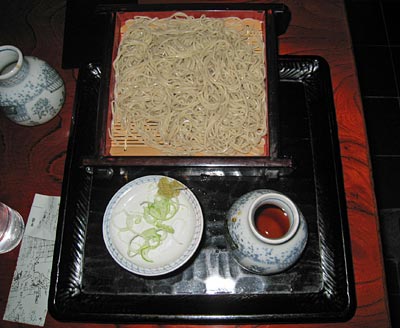- Yummy top
- Eateries and restaurants
- Uoyu - lunch restaurant
- Kanno
- Tokachiya
- Kitchen Nankai - Jinbocho
- Lamb Meat Tender
- Fujiyoshi - tempura restau.
- Enda - Japanese blue crab
- Fukuda - globefish pot
- Sugimoto
- Fuushi
- Soba restaurant
- Shinano - Akabanebashi
- Juwari-soba Inamuraya
- Ando and Korin
- Toranomon Sunaba
- Izakaya
- subLime and Kakinoki
- Donburi-bachi
- Renka
- Yoshida
- Daini-Chikarashuzo
- Sasagin
- Mugiya - soba izakaya
- Fukube
- Sasashin in Ningyo-cho
- Foreign cuisine
- Pizza Piazza
- Atelier de Fromage
- La Piccola Tavola
- Milieu - salad lunch
- Cafe Moskow - Spanish bar
- Sin Tong Kee
- Sekaihanten
- Miscellaneous
- Cheese & champignon party
- Natural Cheese Contest
- Donburi - rice bowl dish
- Home cooking
- Aji no nanban-zuke
- Spaghetti Carbonara
- Curry rice
Toranomon Sunaba
Toranomon 1-10-6, Minato-ku, 151-0001 TokyoTel: 03-3501-9961
Open from 11:00 to 20:00 (Saturdays till 15:00)
Sundays and Holidays closed
Toranomon Sunaba

Toranomon Sunaba today

Toranomon Sunaba several years ago

Mori soba with a small bottle of sauce and a plate with spice - horseradish and sliced spring onion.

Yuzu kiri
Among them soba restaurants have an expecially long tradition. You will find in Tokyo many soba restaurants with the same name such as Sunaba, Sarashina and Yabu, and might think that they are franchised restaurants. Yes, your understanding is almost correct. However, strictly speaking, those soba restaurants are based on the "noren-wake" system, which dates back to the Edo era.
"Noren" originally meant shop or restaurant curtain, but later gained such additional meanings as goodwill and shop or restaurant as uch. It is a long tradition in Japan that young would-be cooks start to work at a prestigious restaurant as trainees. After many years of tough training they are allowed to be independent and open a new restaurant with the same restaurant name. They can also receive financial and other support from the master restaurant. This is called "noren-wake" (assignment of goodwill). The original and new restaurants are not connected by business contracts and royalty payments, but by a relationship similar to that between master and disciple. The restaurants with the same name form a group and help one another.
Toranomon Sunaba is one of the most prominent restaurants of the Sunaba group. "Sunaba" means sandbox or storage place for sand. The origin of Sunaba was a restaurant near the storage place of building materials for Osaka Castle at the end of the 16th century. The founder of the Sunaba group came from Osaka to Tokyo and opened a restaurant west to the palace presumably as early as in the 17th century. Toranomon Sunaba had "noren-wake" directly from the grand master of Sunaba in 1872 and among its earliest guests there were famous people who contributed to the success of the Meiji restoration.
The present building of Toranomon Sunaba was built in 1923. To my surprise, it was moved westwards by two meters during my absence in 2007 to accomodate the widening of the adjacent street. But, the outside aspect of the building is preserved as before and the rearrangement of the interior of the house keeps the old style well. It is worth visiting Sunaba to enjoy its atmosphere.
The average quality of soba has remarkably improved in the past half century, so far as I can experience in Tokyo. I believe this is due to the increased interest in soba among the people, in particular older men. Nowadays making soba is the number one hobby of seniors. Some of them even open their own restaurants after retirement. All professional soba restaurants are therefore forced to try hard to make the best quality noodle using the best ingredients and the most refined skills in soba making.
Toranomon Sunaba is not an exception. When I came here a few decades ago, soba was not especially fine. There was little trace of twist or technique if any.
 But now, their "mori" (simply boiled soba) is one of the best of this kind. The noodle is rather thin and its texture is elastic and resilient. The fragrance of buckwheat is extremely appetizing.
But now, their "mori" (simply boiled soba) is one of the best of this kind. The noodle is rather thin and its texture is elastic and resilient. The fragrance of buckwheat is extremely appetizing.They offer also "kawari soba", soba with additional ingredients such as sesame and perilla. This gives soba eating additional pleasure. The specialty of winter and my favorite kawari soba is "yuzukiri", soba made with yuzu citrus extract. The light yellow soba tastes very refreshing and because of its popularity it sells out extremely quickly.
Sunaba is very busy at lunch time like many other restaurants in business districts, but relatively quiet in the evening. Whenever I sit in a corner, drink sake calmly and taste soba, I feel luxurious and happy. When I was still young, I could not understand the feeling of old men drinking alone in a soba restaurant. But, now I am becoming one of those grandpas and I feel easy here in Sunaba, in particular because I can find many men of the same kind.
